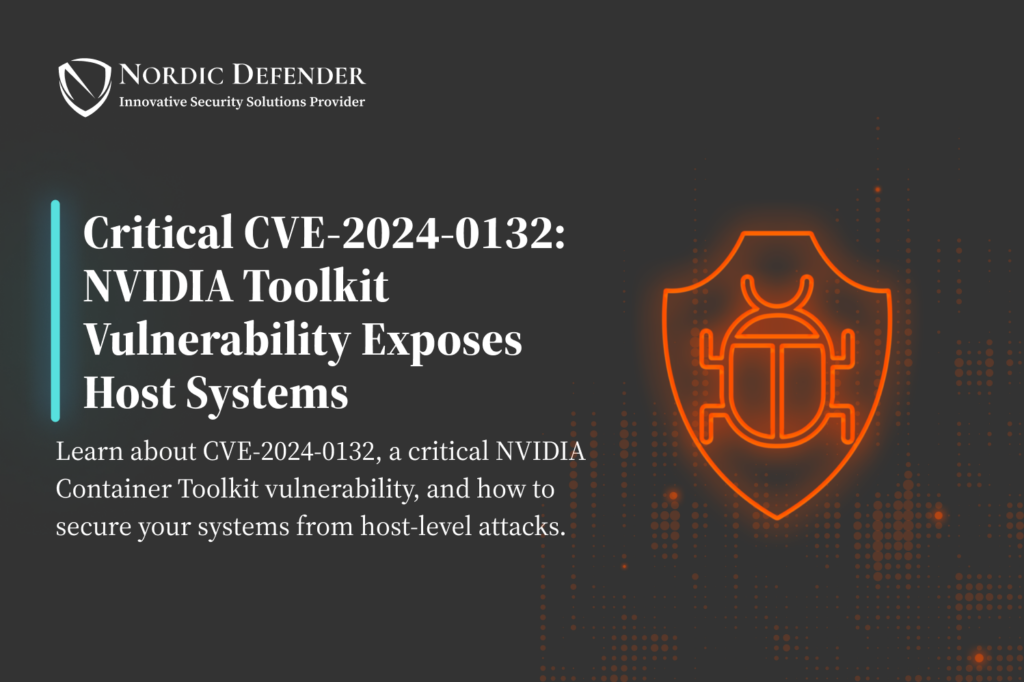A recently discovered vulnerability in NVIDIA’s Container Toolkit (CVE-2024-0132) is sounding alarms across industries that rely heavily on containerized environments for their operations. This security flaw, affecting versions up to 1.16.1, could allow attackers to break free from isolated container environments, enabling unauthorized access to the host system. The implications are severe, with attackers potentially able to escalate privileges, execute code at the host level, and disrupt services.
NVIDIA has acknowledged the issue and promptly released a patch in version 1.16.2. However, systems that have not yet applied this update are at risk of full-scale compromise. Businesses relying on containers for scalability and efficiency must act fast to apply the security update, as the vulnerability represents a critical weak point that could be exploited for malicious gain.
Deep Dive: The Threat Landscape and Why It Matters
In containerized environments, the separation between workloads is a foundational element of security. When that boundary is breached, as in the case of CVE-2024-0132, the impact can be catastrophic. Attackers with access to a compromised container can potentially escape the contained environment and manipulate the host system, undermining the integrity of the entire network.
For companies that use containers to manage applications, workloads, or virtual environments, this means that their key security model is under threat. With containers often handling sensitive business operations and data, the ripple effects of a host-level attack can be far-reaching. This is especially concerning for industries such as finance, healthcare, and cloud service providers, where data breaches and operational downtime can result in severe financial losses and regulatory penalties.
What Does This Mean for Your Organization?
Here’s how this vulnerability impacts your cybersecurity posture and what you can do to protect your organization:
- Loss of Container Isolation: The primary strength of containerization is the isolation it offers. With this vulnerability, attackers can exploit a flaw to escape these isolated environments and gain control over the host system.
- Escalated Privileges: Once on the host machine, attackers can potentially escalate privileges to root access, allowing them to manipulate key processes, steal sensitive information, and even turn the system into a launchpad for additional attacks.
- Denial of Service (DoS): Attackers can initiate DoS attacks that can take entire systems offline, disrupting essential services and leading to costly downtime.
- Data Theft and Tampering: Full access to the host machine means attackers can access or alter sensitive data. In a worst-case scenario, they could tamper with or erase critical information.
How Nordic Defender Can Help
Nordic Defender’s comprehensive cybersecurity platform, NorDef, is built to safeguard your infrastructure from vulnerabilities like CVE-2024-0132. Here’s how we can assist:
- Vulnerability Management: Our Next-Gen Pentest services can identify gaps in your containerized environments and recommend immediate action.
- Proactive Monitoring: Continuous monitoring ensures that threats are detected before they evolve into full-blown security incidents.
- Patch Management: We assist companies in promptly applying critical patches, such as the NVIDIA 1.16.2 update, to keep systems secure.
- Security Audits: Through regular penetration testing and security assessments, we help businesses identify weaknesses in their systems, even those arising from third-party software like the NVIDIA Container Toolkit.
Best Practices for Securing Container Environments
To avoid the consequences of vulnerabilities like CVE-2024-0132, it is essential to follow these best practices:
- Apply Patches Immediately: Ensure you’re running the latest NVIDIA Container Toolkit (version 1.16.2 or later) to mitigate the risk.
- Implement Strict Access Controls: Limit access to containers and hosts, ensuring that only trusted users can interact with sensitive systems.
- Regularly Conduct Security Audits: Frequent penetration testing will help uncover vulnerabilities that could be exploited by attackers.
- Use Multi-Layered Defense Strategies: Combining container security solutions with traditional security measures, like firewalls and intrusion detection systems, creates a robust defense.
- Monitor for Unusual Activity: Deploy monitoring solutions that can detect anomalous behavior, indicating potential breaches or malicious activity.
At Nordic Defender, we provide an all-encompassing solution to defend against the ever-evolving threat landscape. Our offensive and defensive cybersecurity strategies ensure that your systems remain secure, even in the face of vulnerabilities like CVE-2024-0132. Let us help you safeguard your business through comprehensive security audits, penetration testing, and continuous monitoring.
Conclusion
Vulnerabilities like CVE-2024-0132 serve as a stark reminder of the dynamic and unpredictable nature of the cybersecurity landscape. With attackers constantly seeking to exploit weak points, businesses need to stay vigilant, proactive, and up-to-date. Partnering with an expert cybersecurity provider like Nordic Defender ensures that you remain one step ahead of potential threats, protecting your infrastructure, data, and reputation.
